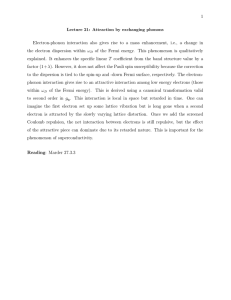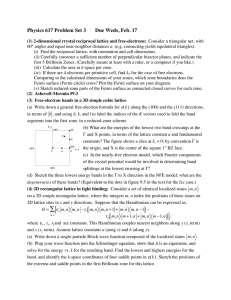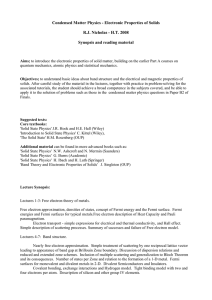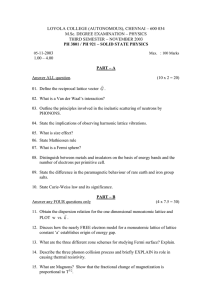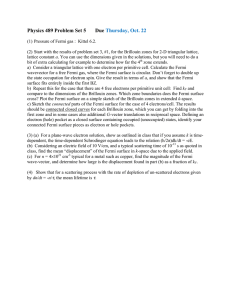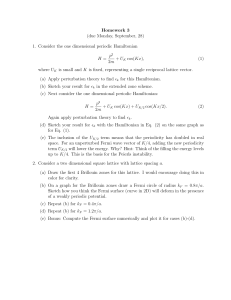The nearly-free electron model - University of Oxford Department of
advertisement
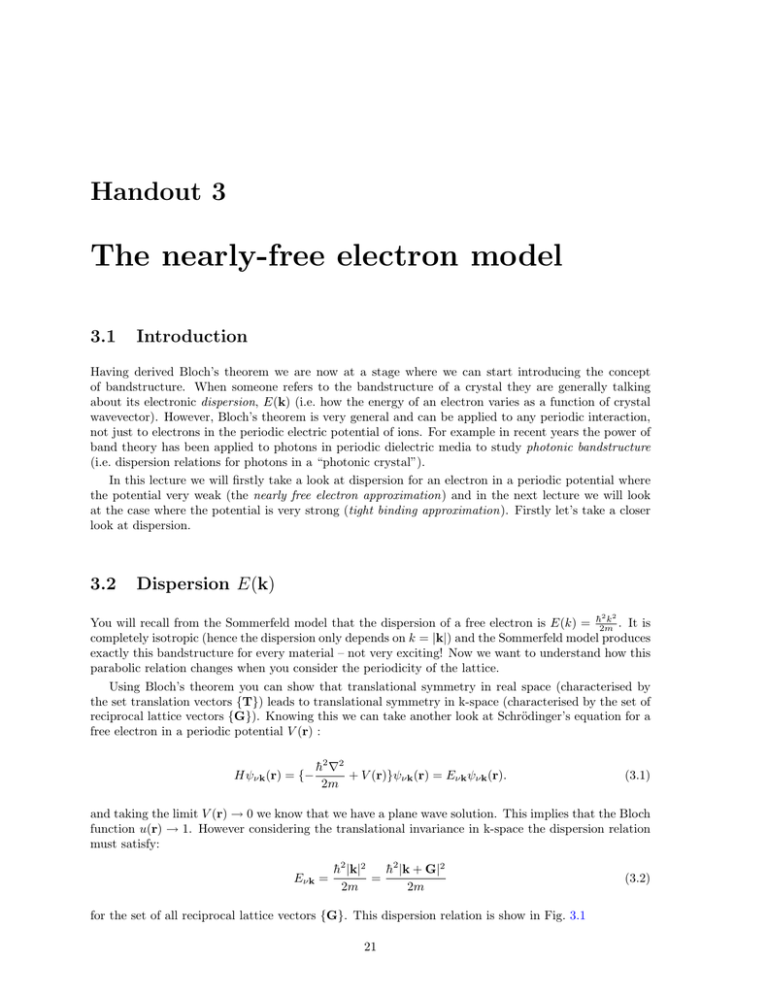
Handout 3
The nearly-free electron model
3.1
Introduction
Having derived Bloch’s theorem we are now at a stage where we can start introducing the concept
of bandstructure. When someone refers to the bandstructure of a crystal they are generally talking
about its electronic dispersion, E(k) (i.e. how the energy of an electron varies as a function of crystal
wavevector). However, Bloch’s theorem is very general and can be applied to any periodic interaction,
not just to electrons in the periodic electric potential of ions. For example in recent years the power of
band theory has been applied to photons in periodic dielectric media to study photonic bandstructure
(i.e. dispersion relations for photons in a “photonic crystal”).
In this lecture we will firstly take a look at dispersion for an electron in a periodic potential where
the potential very weak (the nearly free electron approximation) and in the next lecture we will look
at the case where the potential is very strong (tight binding approximation). Firstly let’s take a closer
look at dispersion.
3.2
Dispersion E(k)
2 2
k
You will recall from the Sommerfeld model that the dispersion of a free electron is E(k) = h̄2m
. It is
completely isotropic (hence the dispersion only depends on k = |k|) and the Sommerfeld model produces
exactly this bandstructure for every material – not very exciting! Now we want to understand how this
parabolic relation changes when you consider the periodicity of the lattice.
Using Bloch’s theorem you can show that translational symmetry in real space (characterised by
the set translation vectors {T}) leads to translational symmetry in k-space (characterised by the set of
reciprocal lattice vectors {G}). Knowing this we can take another look at Schrödinger’s equation for a
free electron in a periodic potential V (r) :
Hψνk (r) = {−
h̄2 ∇2
+ V (r)}ψνk (r) = Eνk ψνk (r).
2m
(3.1)
and taking the limit V (r) → 0 we know that we have a plane wave solution. This implies that the Bloch
function u(r) → 1. However considering the translational invariance in k-space the dispersion relation
must satisfy:
Eνk =
h̄2 |k|2
h̄2 |k + G|2
=
2m
2m
for the set of all reciprocal lattice vectors {G}. This dispersion relation is show in Fig. 3.1
21
(3.2)
22
HANDOUT 3. THE NEARLY-FREE ELECTRON MODEL
E(k)
E(k−G)
E(k)
E(k+G)
E(k)
G
−3π −2π
a
a
−π
a
0
π
a
2 π 3π
a
a
k
−3π −2π
a
a
−π
a
(a)
π
a
0
2 π 3π
a
a
k
(b)
−π
a
0
π
a
k
(c)
Figure 3.1: Simple bandstructure diagrams for a one dimensional periodic solid in the limit V (r) → 0
expressed in the extended zone (a), repeated zone (b), and reduced zone (c) schemes.
3.3
Nearly free electron model
Since we are in the weak potential limit we can treat the crystal potential as a weak perturbation added
to the Hamiltonian of a free electron. Let’s start with the Schrödinger equation for a free electron
Ĥo ψνk (r) = Eνk ψνk (r)
where
Ĥo =
p̂2
2m
(3.3)
(3.4)
which has plane wave eigenstates
ψνk (r) = √
1
exp(ik · r)
Vr3
(3.5)
We now introduce a small perturbation, Ĥ0 associated with the crystal potential
Ĥ = Ĥo + Ĥ0
(3.6)
. Since the lattice is periodic we may expand the perturbation into a Fourier series where {G} are a
set of vectors and VG are Fourier coefficients1
X
Ĥ0 = V (r) =
VG exp(−iG · r).
(3.7)
{G}
Since the lattice is periodic we may expand the perturbation into a Fourier series where G are a set of
vectors and VG are Fourier coefficients.
..
.
Treating the nearly free electron model using degenerate perturbation theory has been
shown on the blackboard during lectures
3.4
Consequences of the nearly-free-electron model.
In the lectures we have derived two simple rules, which are
• away from Brillouin-zone boundaries the electronic bands (i.e. dispersion relationships) are very
similar to those of a free electron;
1 By
considering V (r + Tn ) = V (r) you can show that G turns out to be the reciprocal lattice vector (see Section 2.2)
3.4. CONSEQUENCES OF THE NEARLY-FREE-ELECTRON MODEL.
23
• bandgaps open up whenever E(k) surfaces cross, which means in particular at the zone boundaries.
To see how these rules influence the properties of real metals, we must remember that each band in
the Brillouin zone will contain 2N electron states (see Sections 2.3 and 2.6), where N is the number of
primitive unit cells in the crystal. We now discuss a few specific cases.
3.4.1
The alkali metals
The alkali metals Na, K et al. are monovalent (i.e. have one electron per primitive cell). As a result,
their Fermi surfaces, encompassing N states, have a volume which is half that of the first Brillouin zone.
Let us examine the geometry of this situation a little more closely.
The alkali metals have a body-centred cubic lattice with a basis comprising a single atom. The
conventional unit cell of the body-centred cubic lattice is a cube of side a containing two lattice points
(and hence 2 alkali metal atoms). The electron density is therefore n = 2/a3 . Substituting this in
the equation for free-electron Fermi wavevector (Equation 1.23) we find kF = 1.24π/a. The shortest
distance to the Brillouin zone boundary is half the length of one of the Aj for the body-centred cubic
lattice, which is
1
1 2π 2
π
(1 + 12 + 02 ) 2 = 1.41 .
2 a
a
Hence the free-electron Fermi-surface reaches only 1.24/1.41 = 0.88 of the way to the closest Brillouinzone boundary. The populated electron states therefore have ks which lie well clear of any of the
Brillouin-zone boundaries, thus avoiding the distortions of the band due to the bandgaps; hence, the
alkali metals have properties which are quite close to the predictions of the Sommerfeld model (e.g. a
Fermi surface which is spherical to one part in 103 ).
3.4.2
Elements with even numbers of valence electrons
These substances contain just the right number of electrons (2N p) to completely fill an integer number
p of bands up to a band gap. The gap will energetically separate completely filled states from the next
empty states; to drive a net current through such a system, one must be able to change the velocity of
an electron, i.e move an electron into an unoccupied state of different velocity. However, there are no
easily accessible empty states so that such substances should not conduct electricity at T = 0; at finite
temperatures, electrons will be thermally excited across the gap, leaving filled and empty states in close
energetic proximity both above and below the gap so that electrical conduction can occur. Diamond
(an insulator), Ge and Si (semiconductors) are good examples.
However, the divalent metals Ca et al. plainly conduct electricity rather well. To see why this is
the case, consider the Fermi surface of the two-dimensional divalent metal with a square lattice shown
in Figure 3.2. Initially, the free-electron Fermi surface is a circle with an area equivalent to the first
Brillouin zone (Figure 3.2(a)), which consequently straddles the Brillouin-zone boundary (Figures 3.2(b)
and (c)). Figures 3.2 (d) and (e) show what happens when a weak periodic potential is “turned on”
and bandgaps open up at the Brillouin-zone boundaries; the band gap raises the energy of the states
close to the zone edge in Figure 3.2(c) and lowers those close to the zone edge in Figure 3.2(b) (see
Figure ??). For ease of reference, we shall call the former states “the upper band” and the latter states
“the lower band”. Hence some electrons will transfer back from the upper band (the states above the
gap) to the lower band (the states below it), tending to distort the Fermi surface sections close to the
Brillouin-zone boundaries.
In the situation shown in Figures 3.2(d) and (e), the material is obviously still an electrical conductor,
as filled and empty states are adjacent in energy. Let us call the band gap at the centres of the Brillouinzone edges Egcent and that at the corners of the Brillouin zone Egcorn .2 The lowest energy states in the
upper band will be at points (± πa , 0), (0, ± πa ), where a is the lattice parameter of the square lattice,
with energy
Egcent
h̄2 π 2
u
Elowest
=
+
,
(3.8)
2me a2
2
2 E cent and E corn will in general not be the same; two plane waves contribute to the former and four to the latter.
g
g
However, the gaps will be of similar magnitude.
24
HANDOUT 3. THE NEARLY-FREE ELECTRON MODEL
Figure 3.2: The evolution of the Fermi surface of a divalent two-dimensional metal with a square lattice
as a band gap is opened at the Brillouin zone boundary: (a) free-electron Fermi surface (shaded circle),
reciprocal lattice points (solid dots) and first (square) second (four isoceles triangles) and third (eight
isoceles triangles) Brillouin zones; (b) the section of Fermi surface enclosed by the first Brillouin zone;
(c) the sections of Fermi surface in the second Brillouin zone; (d) distortion of the Fermi-surface section
shown in (b) due to formation of band gaps at the Brillouin-zone boundaries; (e) result of the distortion
of the Fermi-surface section in (c) plus “folding back” of these sections due to the periodicity of k-space.
i.e. the free-electron energy plus half the energy gap. Similarly, the highest energy states in the lower
band will be at the points (± πa , ± πa ), with energy
l
Ehighest
=
Egcorn
h̄2 2π 2
−
,
2me a2
2
(3.9)
i.e. the free-electron energy minus half the energy gap. Therefore the material will be a conductor as
l
u
l
u
long as Ehighest
> Elowest
. Only if the band gap is big enough for Ehighest
< Elowest
, will all of the
electrons be in the lower band at T = 0, which will then be completely filled; filled and empty states
will be separated in energy by a gap and the material will be an insulator at T = 0.
Thus, in general, in two and three dimensional divalent metals, the geometrical properties of the
free-electron dispersion relationships allow the highest states of the lower band (at the corners of the
first Brillouin zone boundary most distant from the zone centre) to be at a higher energy than the lowest
states of the upper band (at the closest points on the zone boundary to the zone centre). Therefore both
bands are partly filled, ensuring that such substances conduct electricity at T = 0; only one-dimensional
divalent metals have no option but to be insulators.
We shall see later that the empty states at the top of the lowest band ( e.g. the unshaded states in
the corners in Figure 3.2(d)) act as holes behaving as though they have a positive charge. This is the
reason for the positive Hall coefficients observed in many divalent metals (see Table 1.1).
3.4.3
More complex Fermi surface shapes
The Fermi surfaces of many simple di- and trivalent metals can be understood adequately by the
following sequence of processes.
1. Construct a free-electron Fermi sphere corresponding to the number of valence electrons.
2. Construct a sufficient number of Brillouin zones to enclose the Fermi sphere.
3.5. READING
25
Figure 3.3: The evolution of the Fermi surface of a divalent two-dimensional metal as a band gap is
opened at the Brillouin zone boundary. (a) Free-electron Fermi circle and rectangular Brillouin zone;
(b) the effect of a band gap opening up at the Brillouin-zone boundary; (c) resulting Fermi surface
sections in the extended-zone scheme.
3. Split and “round off” the edges of the Fermi surface wherever it cuts a Brillouin-zone boundary
(i.e. points at which band-gaps opens up).
4. Apply the periodicity of k-space by replicating all of the Fermi-surface sections at equivalent
points in the first Brillouin zone.
These steps are illustrated in great detail for a number of cases in e.g. Solid State Physics, by N.W
Ashcroft and N.D. Mermin (Holt, Rinehart and Winston, New York 1976) Chapter 9.
Note that the shape of the Brillouin zone has a profound effect on the Fermi surface sections
generated, as shown by the Fermi surface of Figure 3.3. As in Figure 3.2, we have a divalent metal.
However, in Figure 3.3, the Brillouin zone is rectangular, rather than square, so that the Fermi surface
only cuts two of the Brillouin zone edges. Thus, after band gaps have opened up, the Fermi surface
consists of a closed ellipse plus corrugated open lines, rather than the two closed sections of Figure 3.2.
3.5
Reading
An expansion of this material is given in Band theory and electronic properties of solids, by John Singleton (Oxford University Press, 2001), Chapter 3. A more detailed treatement of traditional elemental
metals is given in Solid State Physics, by N.W Ashcroft and N.D. Mermin (Holt, Rinehart and Winston, New York 1976) Chapters 8, 9, 10 and 12 (even if you understand nothing of the discussion, the
pictures are good). Simpler discussions are available in Electricity and Magnetism, by B.I. Bleaney and
B. Bleaney, revised third/fourth editions (Oxford University Press, Oxford) Chapter 12, Solid State
Physics, by G. Burns (Academic Press, Boston, 1995) Sections 10.1-10.21, Electrons in Metals and
26
HANDOUT 3. THE NEARLY-FREE ELECTRON MODEL
Semiconductors, by R.G. Chambers (Chapman and Hall, London 1990) Chapters 4-6, Introduction to
Solid State Physics, by Charles Kittel, seventh edition (Wiley, New York 1996) Chapters 8 and 9.
